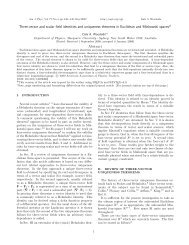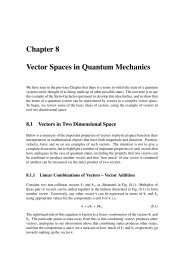Electrostatic Fields in Matter
Electrostatic Fields in Matter
Electrostatic Fields in Matter
You also want an ePaper? Increase the reach of your titles
YUMPU automatically turns print PDFs into web optimized ePapers that Google loves.
7 Permittivity and SusceptibilityThe permittivity (and dielectric constant) are related to the susceptibility.For simplicity we consider the case of a constant field, as foundbetween parallel plates. We can then omit the vector nature of thefield.From Gauss’s lawUs<strong>in</strong>g (9) and (4):E = σ f − Pɛ 0E = σ f − σ bɛ 0(13)= σ f − ɛ 0 χ e Eɛ 0giv<strong>in</strong>g E = σ fɛ 011 + χ e(14)The field is reduced by the factor χ e + 1. The capacitance is<strong>in</strong>creased by the same factor. Keep<strong>in</strong>g <strong>in</strong> m<strong>in</strong>d the def<strong>in</strong>ition of thedielectric constant, we have:K = ɛ r = χ e + 1 (15)The permittivity of a dielectric is : ɛ = ɛ r ɛ 0Equation (14) could be written <strong>in</strong> a variety of ways:E =σ fɛ 0 (1 + χ e ) = σ f= σ fɛ r ɛ 0 ɛ(16)Equation (16) illustrates an important po<strong>in</strong>t. In dielectrics it isusually possible to use the normal equations for calulat<strong>in</strong>g electricfields due to free charges by replac<strong>in</strong>g ɛ 0 by ɛ.8
















